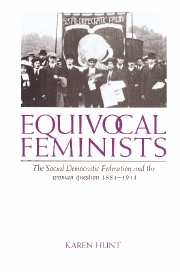Book contents
- Frontmatter
- Contents
- Acknowledgements
- Introduction
- Part 1 The woman question: the theory
- Part 2 The SDF and the woman question: the theory and practice of the party on aspects of the woman question
- Part 3 Women and the SDF: the practical implications of the SDF's understanding of the woman question
- 7 The SDF's attitude to women as potential socialists
- 8 Women SDFers and their role in the party
- 9 The organisation of women within the SDF
- Conclusion
- Appendices
- Bibliography
- Index
9 - The organisation of women within the SDF
Published online by Cambridge University Press: 14 January 2010
- Frontmatter
- Contents
- Acknowledgements
- Introduction
- Part 1 The woman question: the theory
- Part 2 The SDF and the woman question: the theory and practice of the party on aspects of the woman question
- Part 3 Women and the SDF: the practical implications of the SDF's understanding of the woman question
- 7 The SDF's attitude to women as potential socialists
- 8 Women SDFers and their role in the party
- 9 The organisation of women within the SDF
- Conclusion
- Appendices
- Bibliography
- Index
Summary
This chapter is concerned with the changing attitudes of SDFers to women's self-organisation. To what degree did the SDF's understanding of the woman question allow for women to organise as a group? This issue brought to the fore the relationship between class and sex as a matter of practice, rather than just one of theory. The discussion about the various functions that women's organisation could perform for the parent party reflected deeply held assumptions about women and their potential. But this was not an issue which split the SDF neatly along gender lines. It brought to the surface all the ambivalence of the party's understanding of the woman question.
The debate was not conducted in the abstract. The various forms that women's organisation took, their stated purpose and relative success, all affected future choices that women made about organisation. They also influenced the parameters later set for women's organisation by the party as a whole. These factors must be borne in mind when weighing the degree of autonomy desired and achieved by the different stages of SDF women's organisation against their access to power and resources within the party as a whole. All women's organisations within the Second International were faced with these same choices: autonomy, but at the price of marginality; access to the resources and power structure of the party, but at the price of absorption.
- Type
- Chapter
- Information
- Equivocal FeministsThe Social Democratic Federation and the Woman Question 1884–1911, pp. 217 - 250Publisher: Cambridge University PressPrint publication year: 1996

